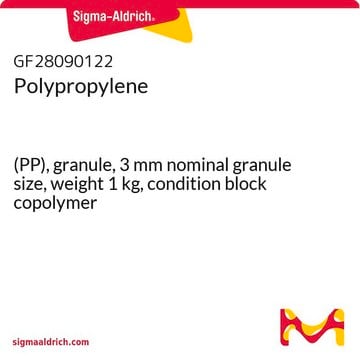ERMEC591
Polypropylene (PP)
ERM®, certified reference material
Synonym(s):
Polypropylene
About This Item
Recommended Products
grade
certified reference material
Agency
ERM®
manufacturer/tradename
JRC
density
0.9 g/mL at 25 °C (lit.)
application(s)
chemicals and industrial polymers
format
neat
storage temp.
−20°C
SMILES string
CC=C
InChI
1S/C22H42O3/c1-2-3-4-5-11-14-17-20-21(25-20)18-15-12-9-7-6-8-10-13-16-19-22(23)24/h20-21H,2-19H2,1H3,(H,23,24)/t20-,21+/m1/s1
InChI key
NSYDMBURIUSUDH-RTWAWAEBSA-N
Looking for similar products? Visit Product Comparison Guide
Analysis Note
ERMEC591
Legal Information
Storage Class Code
11 - Combustible Solids
WGK
WGK 3
Flash Point(F)
Not applicable
Flash Point(C)
Not applicable
Choose from one of the most recent versions:
Certificates of Analysis (COA)
Sorry, we don't have COAs for this product available online at this time.
If you need assistance, please contact Customer Support.
Already Own This Product?
Find documentation for the products that you have recently purchased in the Document Library.
Customers Also Viewed
Our team of scientists has experience in all areas of research including Life Science, Material Science, Chemical Synthesis, Chromatography, Analytical and many others.
Contact Technical Service



